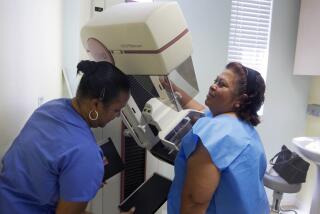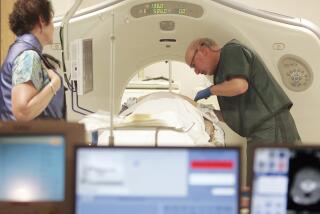Group recommends less-frequent Pap tests
- Share via
Only days after a federal panel scaled back on breast cancer screening recommendations for many women, another organization -- the American College of Obstetricians and Gynecologists -- has done the same for a screening credited with drastically reducing the rates of cervical cancer in the U.S.
Women of all ages should undergo Pap smears less frequently than they do now, those new guidelines say. And young women are advised not to bother until age 21.
The pullback follows the U.S. Preventive Services Task Force’s dismissal of routine breast cancer screenings for women younger than 50. That move triggered a storm of protest from medical groups and individual women, with some breast cancer specialists and Republicans accusing health officials of moving toward a rationing of care and services.
On Wednesday, U.S. Health and Human Services Secretary Kathleen Sebelius emphasized that the task force guidelines amounted to advice, not policy, and that women should continue to consult with their physicians about mammograms based on their own histories and needs.
But together, the two sets of revisions might give rise to a suspicion that women’s health has suddenly taken a back seat to economic pressures, cancer specialists acknowledged Thursday. The annual Pap smear is the only reason some women see a physician, and some doctors fear that, without a sense of urgency to get that test, many women might skip preventive healthcare.
“I understand some people may have a cynical view of this,” said Robert A. Smith, the American Cancer Society’s director of cancer screening. “But we want to assure women this is not motivated to save money.”
Both sets of revisions emphasize the risks associated with annually screening millions of people who will never get breast or cervical cancer. But the creators of the cervical screening recommendations say the two sets of guidelines are markedly different.
For starters, the cervical screening recommendations reflect a broad consensus among medical groups. Most organizations agree that Pap testing does not lose its value if women are screened less frequently, said Dr. Edward Partridge, chairman of the cervical cancer screening guidelines panel for the National Comprehensive Cancer Network.
“Annual screening is too much,” he said. “There is no real controversy there.”
Further, the updated guidelines are based less on the potential for inaccurate results -- the concern regarding mammograms for women under 50 -- than on evolving knowledge about how cervical cancer develops. The disease progresses slowly, and many precancerous changes resolve on their own.
In the Pap test, cells are collected from the cervix and examined for abnormalities. Introduced in the 1940s, the test is considered the most successful cancer screen in medical history, reducing cervical cancer deaths in the U.S. by more than 70% over the last half-century. Death rates fell from 14.8 cases per 100,000 women in 1975 to 6.5 per 100,000 in 2006.
At the same time, the test has given rise to an increased awareness about women’s sexual and reproductive health. Thus, some doctors -- and many women -- are likely to be wary of less-frequent screening, said Dr. Sarah Feldman, an associate professor at Harvard Medical School who specializes in gynecological oncology.
“Ob-gyns may have a problem with it,” she said. “Many feel the reason women come in for an annual exam is for their Pap.”
Dr. Alan G. Waxman, who helped write the new Pap test guidelines, published today in the journal Obstetrics & Gynecology, responded to such concerns by saying that doctors should counsel women that an annual check-up remains a good idea, even if a mammogram or Pap test is not scheduled.
The most significant change in the recommended guidelines is for young women. Previously, the American College of Obstetricians and Gynecologists recommended they get an initial Pap test three years after becoming sexually active or at age 21 -- whichever came first. The new recommendation calls for a first screening at age 21 regardless of when women become sexually active.
The second major change reduces screening for women age 21 to 29 who are not at increased risk for developing cervical cancer, from annually to every two years.
Also in the new document: Women age 30 or older who are at low risk should be tested every three years -- instead of every two to three years -- after having three normal Pap tests in a row.
“It decreases a lot of unnecessary screening among women who are at low risk,” Feldman said. “It means less attention, less cost and less anxiety for the low-risk patient.”
The college did not alter two key recommendations: Women 65 and older can stop having screening depending on individual risk factors and history of previous abnormal Pap tests. And women at higher risk for cervical cancer -- those who have had previous positive tests for cancerous or precancerous changes, are HIV-positive, have immune-system disorders or were exposed to the drug diethylstilbestrol (DES) in utero -- should continue with frequent screening.
The government-sponsored Preventive Services Task Force and the American Cancer Society will release updated cervical cancer guidelines next year that are expected to closely follow the College of Obstetricians and Gynecologists’ new policy.
“The guidelines are more similar than different,” said the cancer society’s Smith. Less screening, he said, “is the direction we’re all moving in.”
The biggest effect of the new recommendations will be to reduce millions of unnecessary tests and follow-up procedures in teenage and young-adult women, Waxman said.
Human papillomavirus, or HPV, which causes cervical cancer and infects half of all young women within a few years of sexual activity’s start, also causes cell changes called dysplasia. Those abnormal cells are typically removed before they become cancerous. But such treatment may not be necessary.
“When teens get these changes, it behaves differently,” Waxman said. “They are more likely to get better by themselves and less likely to get cancer.”
For adult women, annual screening was originally based on the concept that the longer women wait between Pap tests, the more likely they are to have a significant abnormality, Waxman said. But recent research has found that it makes no difference in detecting cellular abnormalities if women return for another test one, two or three years after a normal test.
About 3 million to 4 million abnormal Pap results are found each year, according to the National Cancer Institute, but only about 13,000 cases of cervical cancer are diagnosed. About 4,000 women die each year of the disease.
shari.r [email protected]
More to Read
Sign up for Essential California
The most important California stories and recommendations in your inbox every morning.
You may occasionally receive promotional content from the Los Angeles Times.










